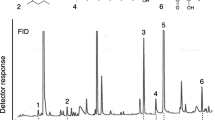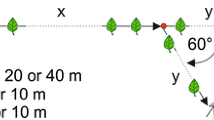Abstract
Foragers of many species of stingless bees guide their nestmates to food sources by means of scent trails deposited on solid substrates between the food and the nest. The corresponding trail pheromones are generally believed to be produced in the mandibular glands, although definitive experimental proof has never been provided. We tested the trail following behavior of recruits of Trigona recursa in field experiments with artificial scent trails branching off from natural scent trails of this stingless bee. First-time recruits (newcomers) did not follow these trails when they were laid with pure solvent or mandibular gland extract. However, they did follow trails made with labial gland extract. Chemical analyses of labial gland secretions revealed that hexyl decanoate was the dominant component (72.4 ± 1.9% of all volatiles). Newcomers were significantly attracted to artificial trails made with synthetic hexyl decanoate, demonstrating its key function in eliciting scent-following behavior. According to our experiments with T. recursa, the trail pheromone is produced in the labial glands and not in the mandibular glands. Hexyl decanoate is the first component of a trail pheromone identified and proved to be behaviorally active in stingless bees.



Similar content being viewed by others
References
Aguilar, I., Fonseca, A., and Biesmeijer, J. C. 2005. Recruitment and communication of food source location in three species of stingless bees (Hymenoptera, Apidae, Meliponini). Apidologie 36:313–324.
Alcock, J. 2001. Animal Behavior: An Evolutionary Approach, 7th edn. Sinauer Associates Inc., Sunderland, MA.
Blum, M. S., Crewe, R. M., Kerr, W. E., Keith, L. H., Garrison, A. W., and Walker, M. M. 1970. Citral in stingless bees: isolation and functions in trail-laying and robbing. J. Insect Physiol. 16:1637–1648.
Cruz López, L., Patricio, E. F. L. R. A., Maile, R., and Morgan, E. D. 2002. Secretions of stingless bees: cephalic secretions of two Frieseomelitta species. J. Insect Physiol. 48:453–458.
da Cruz Landim, C. 1967. Estudo comparativo de algumas glândulas das abelhas (Hymenoptera, Apoidea) e respectivas implicações evolutivas. Arq. Zool. Estado São Paulo 15:177–290.
Francke, W., Lübke, G., Schröder, W., Reckziegel, A., Imperatriz-Fonseca, V. L., Kleinert, A., Engels, E., Hartfelder, K., Radtke, R., and Engels, W. 2000. Identification of oxygen containing volatiles in cephalic secretions of workers of Brazilian stingless bees. J. Braz. Chem. Soc. 11:562–571.
Free, J. B. 1987. Pheromones of Social Bees. Cornell University Press, Ithaca, NY.
Hölldobler, B. and Wilson, E. O. 1990. The Ants. Springer Verlag, Berlin Heidelberg New York.
Jarau, S., Hrncir, M., Schmidt, V. M., Zucchi, R., and Barth, F. G. 2003. Effectiveness of recruitment behavior in stingless bees (Apidae, Meliponini). Insectes Soc. 50:365–374.
Jarau, S., Hrncir, M., Zucchi, R., and Barth, F. G. 2004. A stingless bee uses labial gland secretions for scent trail communication (Trigona recursa Smith 1863). J. Comp. Physiol. A 190:233–239.
Johnson, L. K. 1987. Communication of food source location by the stingless bee Trigona fulviventris, pp. 698–699, in J. Eder and H. Rembold (eds.). Chemistry and Biology of Social Insects. Verlag Peperny, Munich.
Keeling, C. I., Plettner, E., and Slessor, K. N. 2004. Hymenopteran semiochemicals. Top. Curr. Chem. 239:133–177.
Kerr, W. E. 1969. Some aspects of the evolution of social bees (Apidae). Evol. Biol. 3:119–175.
Kerr, W. E. and da Costa Cruz, C. 1961. Funções diferentes tomadas pela glândula mandibular na evolução das abelhas em geral e em “Trigona (Oxytrigona) tataira” em especial. Rev. Bras. Biol. 21:1–16.
Kerr, W. E., Ferreira, A., and de Mattos, N. S. 1963. Communication among stingless bees—additional data (Hymenoptera: Apidae). J. N. Y. Entomol. Soc. 71:80–90.
Lindauer, M. and Kerr, W. E. 1958. Die gegenseitige Verständigung bei den stachellosen Bienen. Z. Vgl. Physiol. 41:405–434.
Lindauer, M. and Kerr, W. E. 1960. Communication between the workers of stingless bees. Bee World 41:29–41, 65–71.
McLafferty, F. W. and Stauffer, D. R. (eds.) 1989. The Wiley/NBS Registry of Mass Spectral Data. Wiley Interscience, New York.
Michener, C. D. 1974. The Social Behavior of the Bees: A Comparative Study. Belknap Press, Cambridge, MA.
Moore, B. P. 1974. Pheromones in the termite societies, pp. 250–266, in M. C. Birch (ed.). Pheromones. North-Holland Publishing Company, Amsterdam.
Morgan, E. D. 1990. Insect trail pheromones: a perspective of progress, pp. 259–270, in A. R. McCaffery and I. D. Wilson (eds.). Chromatography and Isolation of Insect Hormones and Pheromones. Plenum Press, New York.
Nieh, J. C., Contrera, F. A. L., and Nogueira-Neto, P. 2003. Pulsed mass recruitment by a stingless bee, Trigona hyalinata. Proc. R. Soc. Lond. B 270:2191–2196.
Nieh, J. C., Contrera, F. A. L., Yoon, R. R., Barreto, L. S., and Imperatriz-Fonseca, V. L. 2004. Polarized short odor-trail recruitment communication by a stingless bee, Trigona spinipes. Behav. Ecol. Sociobiol. 56:435–448.
Roubik, D. W. 1989. Ecology and Natural History of Tropical Bees. Cambridge University Press, Cambridge.
Sanchéz, D., Nieh, J. C., Hénaut, Y., Cruz, L., and Vandame, R. 2004. High precision during food recruitment of experienced (reactivated) foragers in the stingless bee Scaptotrigona mexicana (Apidae, Meliponini). Naturwissenschaften 91:346–349.
Schmidt, V. M., Zucchi, R., and Barth, F. G. 2003. A stingless bee marks the feeding site in addition to the scent path (Scaptotrigona aff. depilis Moure 1942). Apidologie 34:237–248.
Snodgrass, R. E. 1956. Anatomy of the Honey Bee. Comstock Publishing Association, Ithaca, NY.
Wilson, E. O. 1971. The Insect Societies. Belknap Press, Cambridge, MA.
Wyatt, T. D. 2003. Pheromones and Animal Behaviour. Communication by Smell and Taste. Cambridge University Press, Cambridge.
Acknowledgments
We are very grateful to Sidnei Mateus and Geusa de Freitas for their help in locating the bee nests on the University Campus. This study was supported by grant P-14328 of the Austrian Science Foundation (FWF) to F.G.B. and by money made available by the “Fonds der Chemischen Industrie” to W.F.
Author information
Authors and Affiliations
Corresponding author
Rights and permissions
About this article
Cite this article
Jarau, S., Schulz, C.M., Hrncir, M. et al. Hexyl Decanoate, the First Trail Pheromone Compound Identified in a Stingless Bee, Trigona recursa . J Chem Ecol 32, 1555–1564 (2006). https://doi.org/10.1007/s10886-006-9069-0
Received:
Revised:
Accepted:
Published:
Issue Date:
DOI: https://doi.org/10.1007/s10886-006-9069-0




